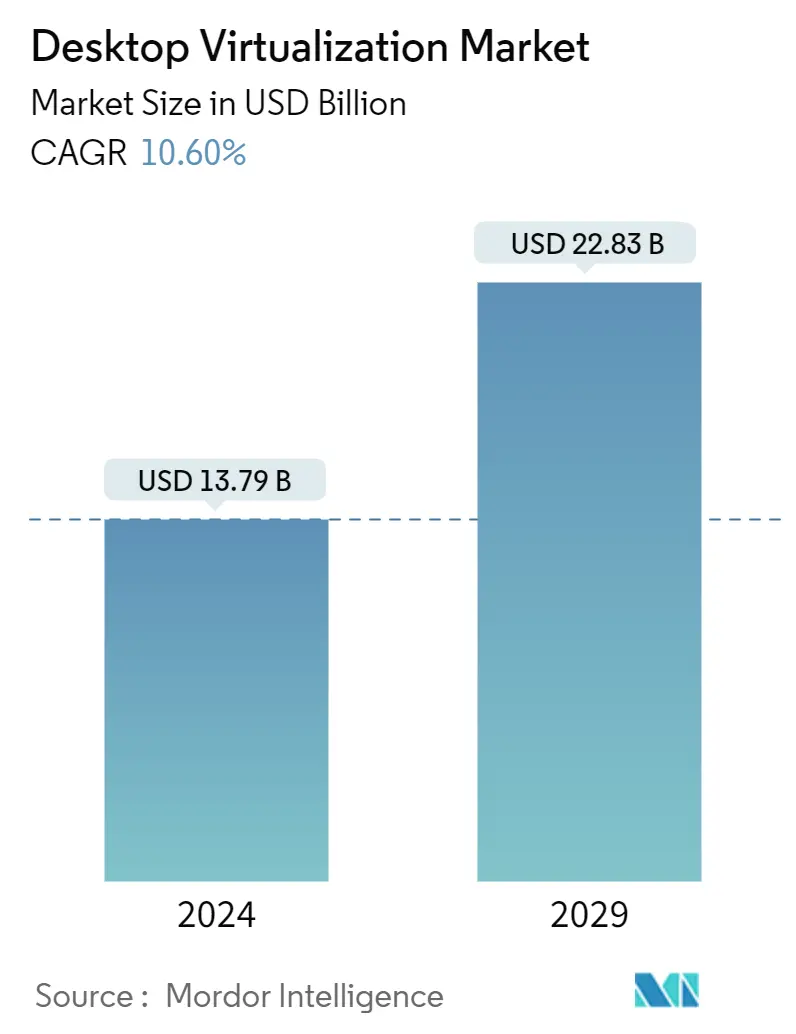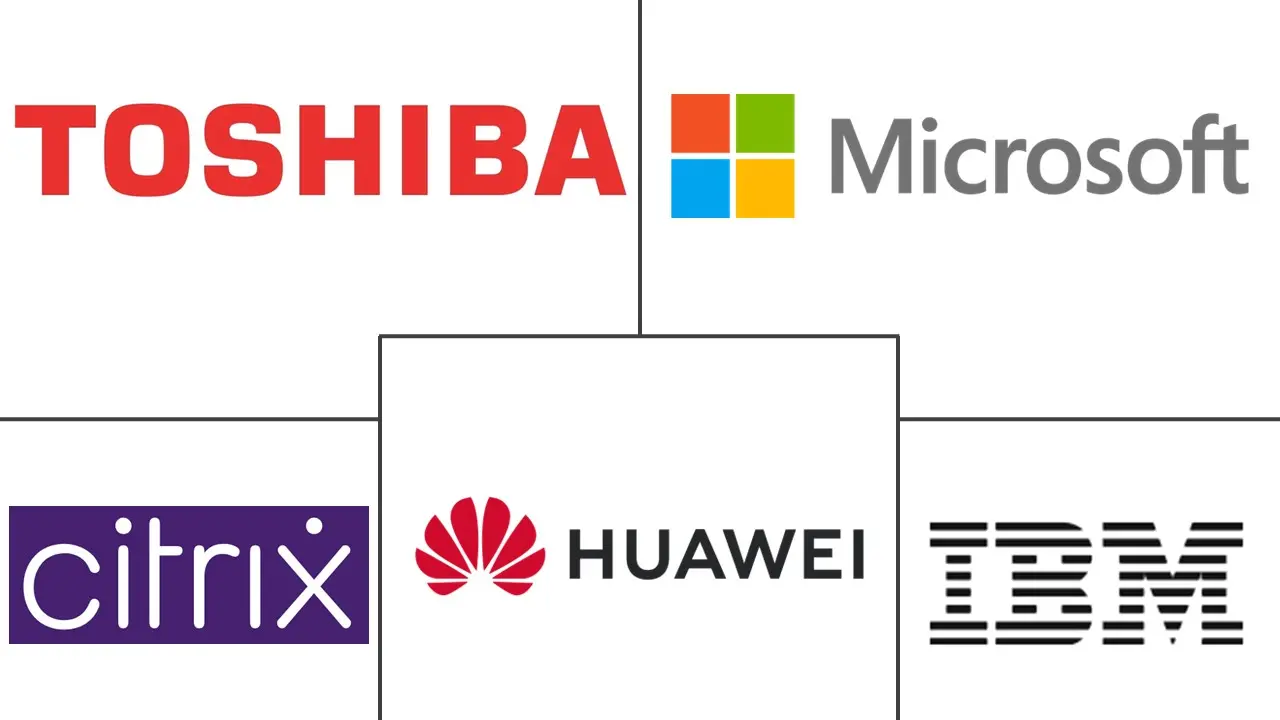Market Size of Desktop Virtualization Industry

| Study Period | 2019 - 2029 |
| Market Size (2024) | USD 13.79 Billion |
| Market Size (2029) | USD 22.83 Billion |
| CAGR (2024 - 2029) | 10.60 % |
| Fastest Growing Market | Asia Pacific |
| Largest Market | North America |
| Market Concentration | Low |
Major Players
*Disclaimer: Major Players sorted in no particular order |
Desktop Virtualization Market Analysis
The Desktop Virtualization Market size is estimated at USD 13.79 billion in 2024, and is expected to reach USD 22.83 billion by 2029, growing at a CAGR of 10.60% during the forecast period (2024-2029).
Desktop Virtualization is completely in sync with cost reduction. Hence, cost-effectiveness is expected to be a key driving factor for the growth of the market.
- Desktop virtualization is valuable for small and medium businesses, as it lowers expenditure on hardware and reduces system administration and maintenance costs. It provides a superior computing experience and solves several complex problems. As a result, desktop virtualization has several benefits, such as a reduction of operational costs and increased user satisfaction, which is expected to fuel the growth of the desktop virtualization market during the forecast period.
- The growing adoption of cloud computing and increasing demand for BYOD in the workplace are significant factors driving this market. By implementing desktop virtualization, employers can leverage BYOD to boost the flexibility and security of both a remote workforce and those working in the office. Employees that use desktop virtualization have access to a secure, monitored desktop from almost any location and on any device.
- The ability to lower complexity and deliver apps to various mobile users is boosting the adoption of desktop virtualization in all types of businesses. The advancements in management and storage make it a more viable option, which is driving the adoption of the market worldwide.
- Infrastructural constraints are hindering the growth of the market. Desktop virtualization increases the complexity of delivering Windows desktops and applications. For virtual desktops to perform as intended, several layers of technology have to work in harmony. The need for new infrastructure, along with the costs associated with it, is one of the major constraints for the growth of the desktop virtualization market.
- The market has been brought to focus since COVID-19 because many businesses have turned to remote working. The lockdown and social distancing guidelines forced many businesses to make the necessary adjustments immediately and build the computer infrastructure needed to support their remote workers. Businesses have been using desktop virtualization solutions for a long time.
Desktop Virtualization Industry Segmentation
Desktop virtualization is a virtualization technique that separates a personal computing desktop from a physical machine using the client-server computing model. This has become a mainstream IT strategy for companies of all sizes. Desktop virtualization involves the separation of the physical client device from the operating system. The data needed for the desktop is stored in a centralized or remote server and not on the client's device. This allows users to access their data from anywhere and at any time.
The Desktop Virtualization Market is segmented into the desktop delivery platform (hosted virtual desktop, hosted shared desktop), deployment mode (on-premises, cloud), end-user vertical (BFSI, healthcare, manufacturing, IT, and telecommunications), and geography (North America, Europe, Asia Pacific, Latin America, and Middle East and Africa). The report offers market forecasts and size in value (USD) for all the above segments.
| By Desktop Delivery Platform | |
| Hosted Virtual Desktop (HVD) | |
| Hosted Shared Desktop (HSD) | |
| Other Desktop Delivery Forms |
| By Deployment Mode | |
| On-premise | |
| Cloud |
| By End-User Vertical | |
| Financial Services | |
| Healthcare | |
| Manufacturing | |
| IT & Telecommunications | |
| Other End-User Verticals |
| By Geography | |
| North America | |
| Europe | |
| Asia-Pacific | |
| Latin America | |
| Middle East and Africa |
Desktop Virtualization Market Size Summary
The desktop virtualization market is poised for significant growth, driven by its cost-effectiveness and the increasing adoption of cloud computing and BYOD (Bring Your Own Device) policies. This technology is particularly beneficial for small and medium-sized enterprises, as it reduces hardware expenses and system maintenance costs while enhancing user satisfaction and operational efficiency. The market's expansion is further supported by the ability to provide secure, flexible access to desktops from various devices and locations, which is increasingly important in today's remote and hybrid work environments. However, infrastructural challenges and the complexity of delivering virtual desktops and applications remain obstacles to market growth.
North America stands as the largest regional market for desktop virtualization, with the United States leading due to its robust cloud service provider presence and early adoption of new technologies. The region's dominance is bolstered by its IT and telecommunications industry, which seeks to leverage desktop virtualization for enhanced data security and user flexibility. The market is highly fragmented, with major players like Citrix Systems Inc., IBM Corporation, and Microsoft Corporation actively engaging in partnerships and acquisitions to strengthen their offerings. Recent developments, such as Microsoft's Azure Virtual Desktop updates and Citrix's collaboration with Twilio, highlight the ongoing innovation and strategic maneuvers within the industry.
Desktop Virtualization Market Size - Table of Contents
-
1. MARKET INSIGHTS
-
1.1 Market Overview
-
1.2 Industry Attractiveness - Porter's Five Forces Analysis
-
1.2.1 Bargaining Power of Suppliers
-
1.2.2 Bargaining Power of Buyers/Consumers
-
1.2.3 Threat of New Entrants
-
1.2.4 Threat of Substitute Products
-
1.2.5 Intensity of Competitive Rivalry
-
-
1.3 Impact of COVID-19 on the Market
-
-
2. MARKET SEGMENTATION
-
2.1 By Desktop Delivery Platform
-
2.1.1 Hosted Virtual Desktop (HVD)
-
2.1.2 Hosted Shared Desktop (HSD)
-
2.1.3 Other Desktop Delivery Forms
-
-
2.2 By Deployment Mode
-
2.2.1 On-premise
-
2.2.2 Cloud
-
-
2.3 By End-User Vertical
-
2.3.1 Financial Services
-
2.3.2 Healthcare
-
2.3.3 Manufacturing
-
2.3.4 IT & Telecommunications
-
2.3.5 Other End-User Verticals
-
-
2.4 By Geography
-
2.4.1 North America
-
2.4.2 Europe
-
2.4.3 Asia-Pacific
-
2.4.4 Latin America
-
2.4.5 Middle East and Africa
-
-
Desktop Virtualization Market Size FAQs
How big is the Desktop Virtualization Market?
The Desktop Virtualization Market size is expected to reach USD 13.79 billion in 2024 and grow at a CAGR of 10.60% to reach USD 22.83 billion by 2029.
What is the current Desktop Virtualization Market size?
In 2024, the Desktop Virtualization Market size is expected to reach USD 13.79 billion.

